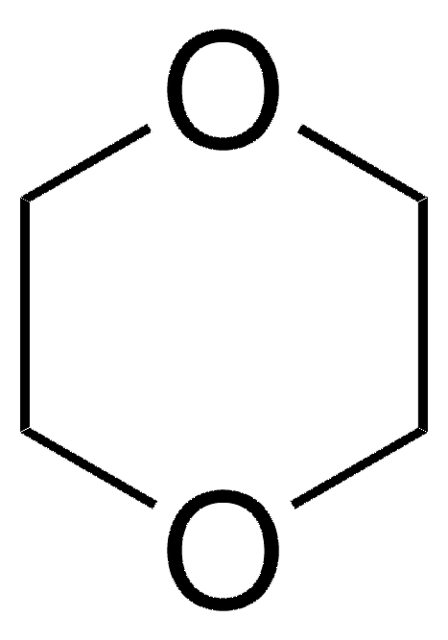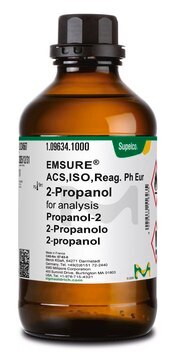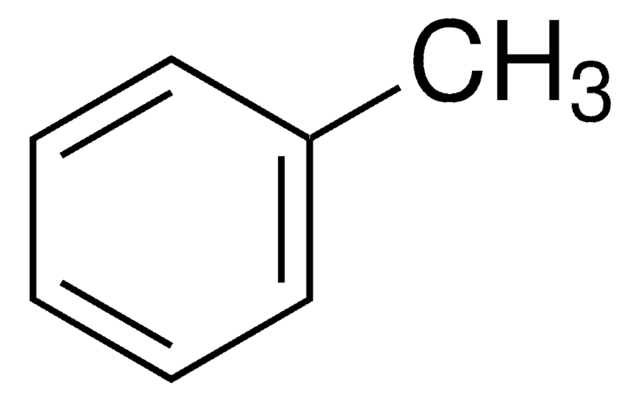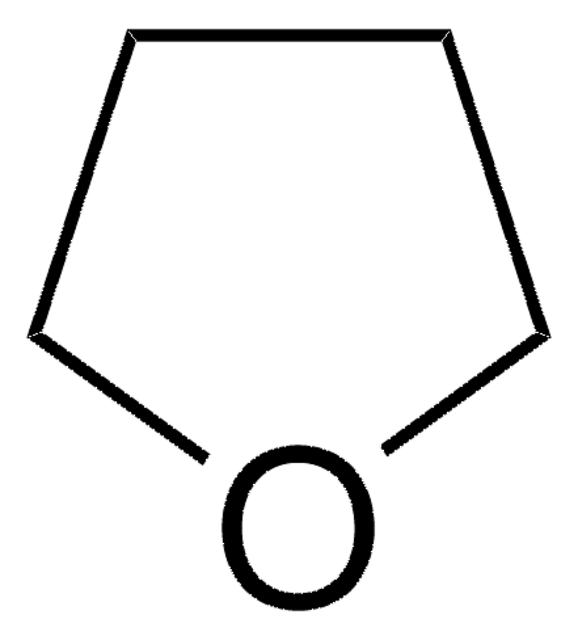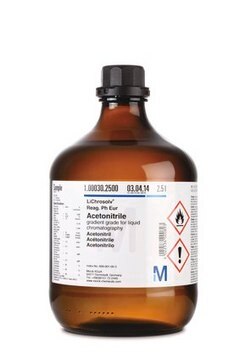1.09671
1,4-Dioxan
for analysis EMSURE® ACS,ISO
Synonym(e):
1,4-Dioxan, Glycolethylether, 1,4-Diethylendioxid, 1,4-Dioxacyclohexan
About This Item
Empfohlene Produkte
Qualität
ACS reagent
Qualitätsniveau
Agentur
reag. ISO
Dampfdruck
41 hPa ( 20 °C)
Produktlinie
EMSURE®
Assay
≥99.5% (GC)
Form
liquid
Selbstzündungstemp.
300 °C
Wirksamkeit
5200 mg/kg LD50, oral (Rat)
7600 mg/kg LD50, skin (Rabbit)
Expl.-Gr.
1.7-25.2 % (v/v)
Verunreinigungen
≤0.0008 meq/g Acidity
≤0.005% Acetaldehyde
≤0.005% Peroxide (as H2O2)
≤0.01% Carbonyl compounds (as CO)
≤0.05% Formaldehyde
≤0.05% Water
Abdampfrückstand
≤0.001%
Farbe
APHA: ≤10
pH-Wert
6-8 (20 °C, 500 g/L in H2O)
bp
101.5 °C/1013 hPa
mp (Schmelzpunkt)
12 °C
Übergangstemp.
flash point 11 °C
Dichte
1.03 g/cm3 at 20 °C
Kationenspuren
Al: ≤0.00005%
B: ≤0.000002%
Ba: ≤0.00001%
Ca: ≤0.00005%
Cd: ≤0.000005%
Co: ≤0.000002%
Cr: ≤0.000002%
Cu: ≤0.000002%
Fe: ≤0.00001%
Mg: ≤0.00001%
Mn: ≤0.000002%
Ni: ≤0.000002%
Pb: ≤0.00001%
Sn: ≤0.00001%
Zn: ≤0.00001%
Lagertemp.
2-30°C
InChI
1S/C4H8O2/c1-2-6-4-3-5-1/h1-4H2
InChIKey
RYHBNJHYFVUHQT-UHFFFAOYSA-N
Verwandte Kategorien
Allgemeine Beschreibung
Anwendung
- Preferential Solvation Phenomena as Solute-Induced Structure-Making/Breaking Processes: Linking Thermodynamic Preferential Interaction Parameters to Fundamental Structure Making/Breaking Functions.: This study explores the solvation dynamics and interactions in solutions containing 1,4-dioxane, highlighting the solute′s influence on molecular arrangements and interactions (Chialvo AA, 2024).
- Green Synthesis of Highly Fluorescent NCQDs: A Comprehensive Study on Synthesis, Characterization, Photophysical Properties, pH Sensing, Heavy Metal Detection, and Solvatochromic Behavior through Hydrothermal Method.: Discusses the development of nanocrystals using 1,4-dioxane as a solvent, focusing on their application in environmental monitoring and chemical sensing (Negi P et al., 2024).
- Concentration Fluctuation/Microheterogeneity Duality Illustrated with Aqueous 1,4-Dioxane Mixtures.: This paper presents a theoretical analysis of the mixture behavior of water and 1,4-dioxane, providing insights into the molecular interactions and solution properties (Kolaříková A et al., 2024).
- Synthesis, molecular docking studies and biological evaluation of N-(4-oxo-2-(trifluoromethyl)-4H-chromen-7-yl) benzamides as potential antioxidant, and anticancer agents.: Explores the synthesis of new compounds using 1,4-dioxane and their potential as therapeutic agents, highlighting the versatility of 1,4-dioxane in drug development (Jorepalli S et al., 2024).
Hinweis zur Analyse
Identität (IR): entspricht
Farbe: ≤ 10 Hazen
Acidität: ≤ 0,0008 meq/g
Dichte (d 20 °C/4 °C): 1,030 - 1,035
Schmelzpunkt: ≥ 11,0 °C
Formaldehyd: ≤ 0,05 %
Acetaldehyd: ≤ 0,005 %
Peroxid (als H₂O₂): ≤ 0,005 %
Carbonylverbindungen (als CO): ≤ 0,01 %
Abdampfrückstand: ≤ 0,001 %
Wasser: ≤ 0,05 %
Al (Aluminium): ≤ 0,00005 %
B (Bor): ≤ 0,000002 %
Ba (Barium): ≤ 0,00001 %
Ca (Calcium): ≤ 0,00005 %
Cd (Cadmium): ≤ 0,000005 %
Co (Cobalt): ≤ 0,000002 %
Cr (Chrom): ≤ 0,000002 %
Cu (Kupfer): ≤ 0,000002 %
Fe (Eisen): ≤ 0,00001 %
Mg (Magnesium): ≤ 0,00001 %
Mn (Mangan): ≤ 0,000002 %
Ni (Nickel): ≤ 0,000002 %
Pb (Blei): ≤ 0,00001 %
Sn (Zinn): ≤ 0,00001 %
Zn (Zink): ≤ 0,00001 %
Stabilisiert mit 25 ppm 2,6-Di-tert-butyl-4-methylphenol (BHT).
ACS, ISO-Reagenz
Rechtliche Hinweise
Signalwort
Danger
H-Sätze
Gefahreneinstufungen
Carc. 1B - Eye Irrit. 2 - Flam. Liq. 2 - STOT SE 3
Zielorgane
Respiratory system
Zusätzliche Gefahrenhinweise
Lagerklassenschlüssel
3 - Flammable liquids
WGK
WGK 3
Flammpunkt (°F)
51.8 °F - closed cup
Flammpunkt (°C)
11 °C - closed cup
Zulassungslistungen
Zulassungslistungen werden hauptsächlich für chemische Produkte erstellt. Für nicht-chemische Produkte können hier nur begrenzte Angaben gemacht werden. Kein Eintrag bedeutet, dass keine der Komponenten gelistet ist. Es liegt in der Verantwortung des Benutzers, die sichere und legale Verwendung des Produkts zu gewährleisten.
EU REACH SVHC Candidate List
Analysenzertifikate (COA)
Suchen Sie nach Analysenzertifikate (COA), indem Sie die Lot-/Chargennummer des Produkts eingeben. Lot- und Chargennummern sind auf dem Produktetikett hinter den Wörtern ‘Lot’ oder ‘Batch’ (Lot oder Charge) zu finden.
Besitzen Sie dieses Produkt bereits?
In der Dokumentenbibliothek finden Sie die Dokumentation zu den Produkten, die Sie kürzlich erworben haben.
Kunden haben sich ebenfalls angesehen
Unser Team von Wissenschaftlern verfügt über Erfahrung in allen Forschungsbereichen einschließlich Life Science, Materialwissenschaften, chemischer Synthese, Chromatographie, Analytik und vielen mehr..
Setzen Sie sich mit dem technischen Dienst in Verbindung.